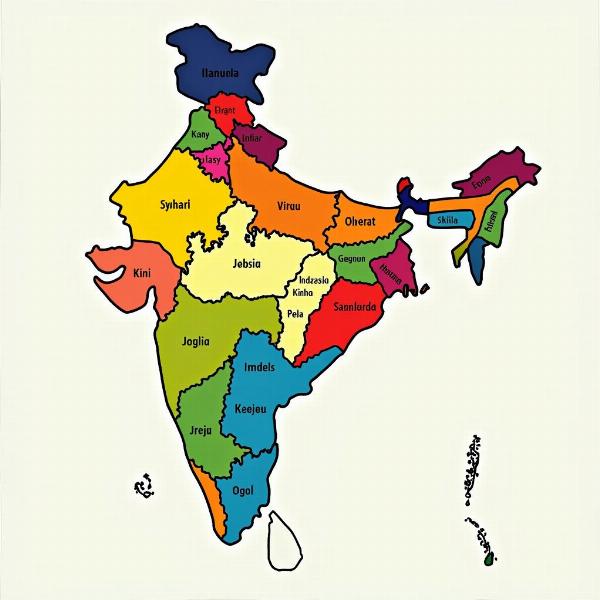“I saw u” – a simple phrase, yet its meaning in Hindi can vary based on context, relationship, and the emotion you want to convey. While a direct translation might be ” मैंने तुम्हें देखा (maine tumhen dekha),” this doesn’t always capture the subtle nuances of the English phrase. This article will delve into the various ways “I saw u” can be expressed in Hindi, exploring the cultural and linguistic factors influencing its interpretation.
Expressing “I Saw U” in Different Contexts
The meaning of “I saw u” hinges heavily on the context. Are you talking to a friend, a family member, or a stranger? Is it a casual observation or a loaded statement? Let’s examine some common scenarios:
Casual Encounters
When you simply want to acknowledge seeing someone, “मैंने तुम्हें देखा (maine tumhen dekha)” is perfectly adequate. For a more informal setting with friends, you could use “देखा तुझे (dekha tujhe).” However, using the informal “tujhe” with elders or strangers is considered disrespectful.
Romantic Implications
If “I saw u” carries a romantic undertone, the Hindi translation becomes more complex. You might say “मैंने तुम्हें देखा था और… (maine tumhen dekha tha aur…)” – “I saw you and…” leaving the rest unsaid, adding an air of mystery and intrigue. A more poetic rendition could be “नज़र पड़ी तुम पर (nazar padi tum par)” – “My eyes fell upon you.”
Expressing Surprise
If you were surprised to see someone, you could express this with “अरे, तुम यहाँ! (arey, tum yahan!)” – “Oh, you’re here!” or “कैसे हो यहाँ? (kaise ho yahan?)” – “What are you doing here?” This shows surprise and initiates a conversation.
Formal vs. Informal Language: Choosing the Right Words
Just like English, Hindi has formal and informal registers. Understanding the distinction is crucial for conveying the intended meaning of “I saw u.” Using “आप (aap)” for “you” indicates respect and formality, while “तुम (tum)” and “तू (tu)” are used for informal settings. Choosing the right pronoun is essential to avoid miscommunication or causing offense.
Addressing Elders and Strangers
When speaking to elders or strangers, always use the respectful “aap” form. For example, “मैंने आपको देखा (maine aapko dekha)” is the appropriate way to say “I saw you.”
Speaking with Friends and Family
With close friends and family, you can use the informal “tum” or even “tu” in some regions. “मैंने तुम्हें देखा (maine tumhen dekha)” or “देखा तुझे (dekha tujhe)” are acceptable in these informal contexts.
Beyond the Direct Translation: Cultural Nuances
In Indian culture, directness is not always appreciated. Sometimes, implying rather than explicitly stating is considered more polite. Therefore, instead of saying “I saw u,” you might ask a related question like “आप कब आए? (aap kab aaye?)” – “When did you arrive?” or “आप कहाँ जा रहे हैं? (aap kahan ja rahe hain?)” – “Where are you going?” This acknowledges their presence without being overly direct.
“I Saw U” in Hindi Literature and Cinema
Hindi literature and cinema often use metaphorical language to express seeing someone. Phrases like “एक झलक देखी (ek jhalak dekhi)” – “caught a glimpse” or “नज़रों से नज़रें मिलीं (nazron se nazrein mili)” – “our eyes met” add depth and romanticism to the simple act of seeing someone. These expressions highlight the emotional impact of the encounter, going beyond a mere visual observation.
How to Say “I Saw U” in Different Hindi Dialects
Hindi, like any language, has numerous dialects. While the core meaning remains consistent, the specific words and pronunciation can vary. In some dialects, “dekha” might be pronounced slightly differently, or an entirely different word might be used. Understanding these regional variations enriches your communication and shows cultural sensitivity.
 Hindi Dialects: Regional Variations
Hindi Dialects: Regional Variations
Conclusion: Choosing the Right Expression for “I Saw U”
As we’ve seen, translating “I saw u” into Hindi isn’t a simple matter of finding the equivalent words. It requires considering the context, relationship, and cultural nuances. By understanding these factors, you can choose the most appropriate expression, ensuring your message is conveyed accurately and respectfully. Whether you opt for a direct translation or a more nuanced phrase, the key is to communicate effectively and appropriately within the Indian cultural context.
FAQ:
- What is the most common way to say “I saw you” in Hindi? The most common way is “मैंने आपको देखा (maine aapko dekha)” (formal) or “मैंने तुम्हें देखा (maine tumhen dekha)” (informal).
- Is it rude to say “dekha tujhe”? It can be considered rude if used with elders or strangers. It’s best reserved for close friends and family.
- How can I express “I saw you” romantically in Hindi? You could say something like “नज़र पड़ी तुम पर (nazar padi tum par)” or “मैंने तुम्हें देखा था और… (maine tumhen dekha tha aur…).”
- Why is it important to understand Hindi dialects when translating? Different dialects have variations in vocabulary and pronunciation, which can impact the meaning and reception of your message.
- Where can I learn more about Hindi grammar and vocabulary? Meaning-Hindi.in offers comprehensive resources and translation services to help you master the nuances of Hindi.
Meaning-Hindi.in is your trusted partner for all your Hindi translation needs. We offer expert translation services in various domains, from business and legal documents to technical manuals and website localization. Our team of experienced translators ensures accurate and culturally sensitive translations, bridging the language gap effectively. Need a quick translation or a specialized linguistic solution? Contact us today at [email protected] or call us at +91 11-4502-7584. Meaning-Hindi.in is here to help you communicate with confidence.